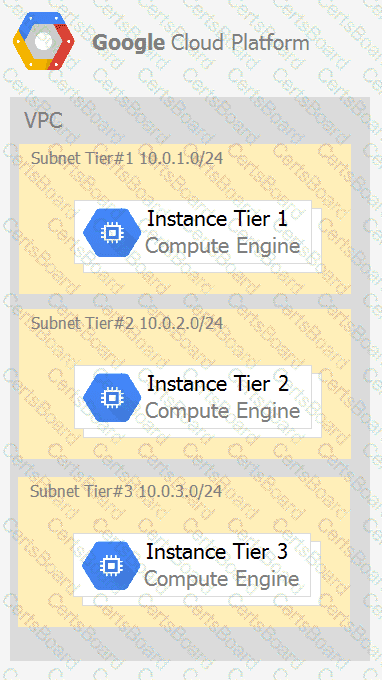You are using Container Registry to centrally store your company’s container images in a separate project. In another project, you want to create a Google Kubernetes Engine (GKE) cluster. You want to ensure that Kubernetes can download images from Container Registry. What should you do?
You need to deploy an application in Google Cloud using savorless technology. You want to test a new version of the application with a small percentage of production traffic. What should you do?
You created a Kubernetes deployment by running kubectl run nginx image=nginx labels=app=prod. Your Kubernetes cluster is also used by a number of other deployments. How can you find the identifier of the pods for this nginx deployment?
Your company has a 3-tier solution running on Compute Engine. The configuration of the current infrastructure is shown below.

Each tier has a service account that is associated with all instances within it. You need to enable communication on TCP port 8080 between tiers as follows:
• Instances in tier #1 must communicate with tier #2.
• Instances in tier #2 must communicate with tier #3.
What should you do?
You deployed an App Engine application using gcloud app deploy, but it did not deploy to the intended project. You want to find out why this happened and where the application deployed. What should you do?
The DevOps group in your organization needs full control of Compute Engine resources in your development project. However, they should not have permission to create or update any other resources in the project. You want to follow Google's recommendations for setting permissions for the DevOps group. What should you do?
You need to update a deployment in Deployment Manager without any resource downtime in the deployment. Which command should you use?
You need to create an autoscaling managed instance group for an HTTPS web application. You want to make sure that unhealthy VMs are recreated. What should you do?
Your company has a large quantity of unstructured data in different file formats. You want to perform ETL transformations on the data. You need to make the data accessible on Google Cloud so it can be processed by a Dataflow job. What should you do?
You are the Google Cloud systems administrator for your organization. User A reports that they received an error when attempting to access the Cloud SQL database in their Google Cloud project, while User B can access the database. You need to troubleshoot the issue for User A, while following Google-recommended practices.
What should you do first?


